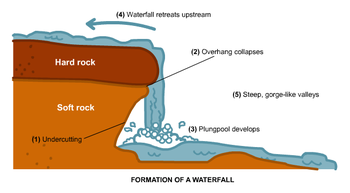Difference between revisions of "AY Honors/Waterfalls/Answer Key"
| Line 19: | Line 19: | ||
==Types of waterfalls== | ==Types of waterfalls== | ||
[[Image:waterfall oregon.jpg|thumb|150px|Cascade-style waterfall in Oregon, United States.]] | [[Image:waterfall oregon.jpg|thumb|150px|Cascade-style waterfall in Oregon, United States.]] | ||
| − | ; Block : | + | ; Block : ALL BLOCKY AND STUUFF! |
| − | ; Cascade : | + | ; Cascade : WOOHOO I'M ON CANDID CAMERA! |
| − | ; Cataract : | + | ; Cataract : EYE PROBLEM |
| − | ; Fan : | + | ; Fan : HI MAYA IT'S nOAH!; Horsetail : POOR HORSEY!; Plunge : me!!!!!!!!!!!!; Punchbowl : MMMM YUMMY; Segmented : Distinctly separate flows of water form as it descends. |
| − | ; Horsetail : | ||
| − | ; Plunge : | ||
| − | ; Punchbowl : | ||
| − | ; Segmented : Distinctly separate flows of water form as it descends. | ||
; Tiered : Water drops in a series of distinct steps or falls. | ; Tiered : Water drops in a series of distinct steps or falls. | ||
Revision as of 22:15, 8 December 2005
A waterfall is usually a geological formation resulting from water, often in the form of a stream flowing over an erosion-resistant rock formation that forms a sudden break in elevation. Waterfalls may also be artificial, and they are sometimes used for garden and landscape ornament.
Some waterfalls form in mountain environments where erosion is rapid and stream courses may be subject to sudden and catastrophic change. In such cases, the waterfall may not be the end product of many years of water action over a region, but rather the result of relatively sudden geological processes such as thrust faults or volcanic action.
Formation
Some waterfalls are the result of action of water on the underlying strata. Typically, a stream will flow across an area of formations, and more resistant rock strata will form shelves across the streamway, elevated above the further stream bed when the less erosion-resistant rock around it disappears. Over a period of years, the edges of this shelf will gradually break away and the waterfall will steadily move upstream. Often, the rock strata just below the more resistant shelf will be of a softer type, and will erode out to form a shallow cave-like formation known as a rock shelter (also known as a rock house) under and behind the waterfall.
Streams often become wider and more shallow just above waterfalls due to flowing over the rock shelf, and there is usually a deep pool just below the waterfall due to the kinetic energy of the water hitting the bottom.
Some water falls have brown water from picking up rust, dirt and clay from the things it passes.
HI NOAHHHH!!!!!!!
Types of waterfalls
- Block
- ALL BLOCKY AND STUUFF!
- Cascade
- WOOHOO I'M ON CANDID CAMERA!
- Cataract
- EYE PROBLEM
- Fan
- HI MAYA IT'S nOAH!; Horsetail : POOR HORSEY!; Plunge : me!!!!!!!!!!!!; Punchbowl : MMMM YUMMY; Segmented : Distinctly separate flows of water form as it descends.
- Tiered
- Water drops in a series of distinct steps or falls.
Examples of large waterfalls
- Angel Falls, the world's highest at 979 m (3230 ft), in Venezuela
- Victoria Falls, the world's largest, on the Zambezi River, on the border between Zambia and Zimbabwe
- Boyoma Falls, with the world's highest volume, 17,000 m³/s (600,000 ft³/s), on the Congo River, Democratic Republic of the Congo
- Yosemite Falls, the tallest in North America, located in Yosemite National Park, United States
- Niagara Falls, most voluminous in North America, on the border between the United States and Canada
- Rhine Falls, Europe's largest, located in Switzerland
- Iguazu Falls, a tall and extremely wide fall located in South America on the Argentina/Brazil border
- Jog Falls, India's highest and second highest in Asia, located in Karnataka state, India
- Jurong Falls in Singapore is said to be the tallest man-made waterfall in the world
Gallery
- Base of Tower Fall with rainbow-750px.JPG
Tower Fall in Yellowstone National Park, United States
Angel Falls, Venezeuela
Wailua Falls in Hawaii, United States
Dettifoss in Iceland
Man made waterfall at the Australian National Botanic Gardens in Canberra, Australia
External links
da:Vandfald de:Wasserfall eo:Akvofalo es:Cascada et:Juga fr:Chute d'eau he:מפל מים it:Cascata ja:滝 nl:Waterval no:Foss nn:Foss pl:Wodospad pt:Cachoeira (cascata) sl:Slap sv:vattenfall








